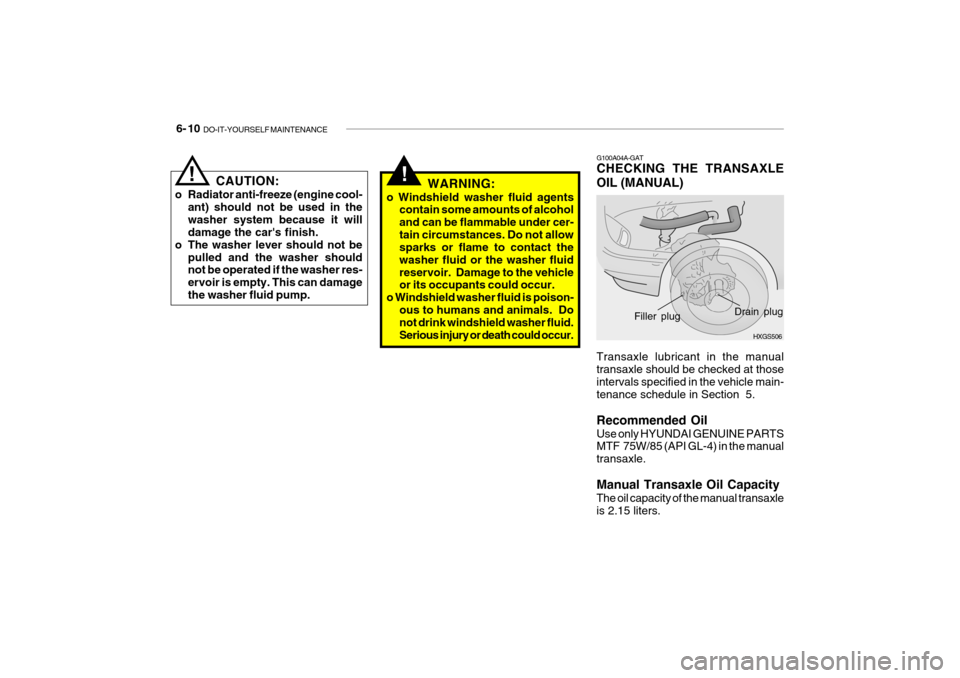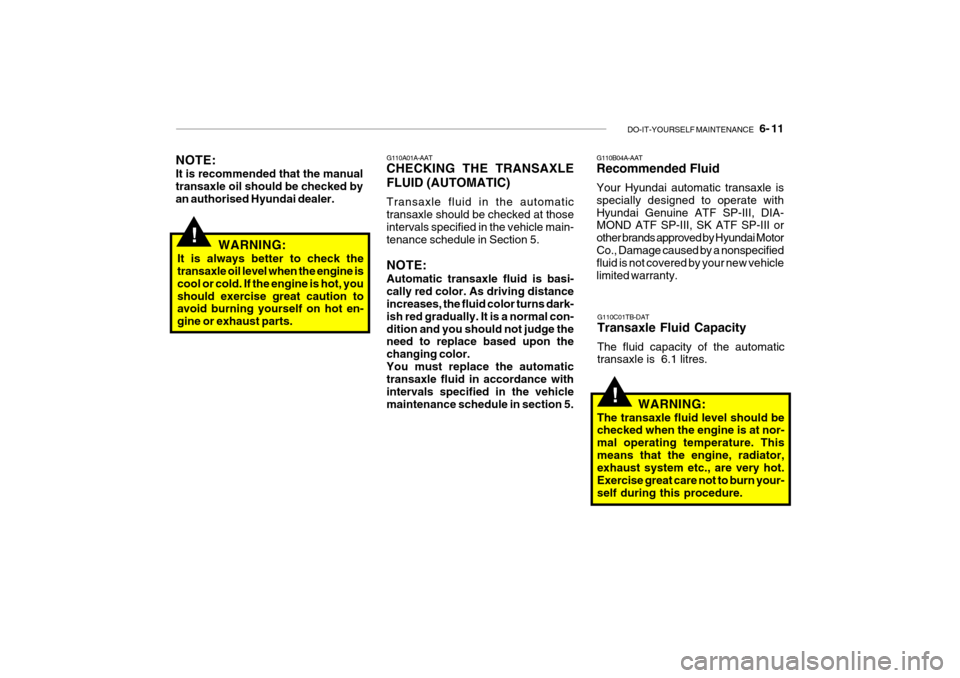2009 Hyundai Getz oil capacity
[x] Cancel search: oil capacityPage 152 of 191

6- 10 DO-IT-YOURSELF MAINTENANCE
!
Transaxle lubricant in the manual transaxle should be checked at those intervals specified in the vehicle main- tenance schedule in Section 5. Recommended Oil Use only HYUNDAI GENUINE PARTS MTF 75W/85 (API GL-4) in the manual transaxle. Manual Transaxle Oil Capacity The oil capacity of the manual transaxle is 2.15 liters.
!
CAUTION:
o Radiator anti-freeze (engine cool- ant) should not be used in the washer system because it will damage the car's finish.
o The washer lever should not be pulled and the washer shouldnot be operated if the washer res- ervoir is empty. This can damagethe washer fluid pump. WARNING:
o Windshield washer fluid agents contain some amounts of alcoholand can be flammable under cer-tain circumstances. Do not allow sparks or flame to contact the washer fluid or the washer fluidreservoir. Damage to the vehicle or its occupants could occur.
o Windshield washer fluid is poison- ous to humans and animals. Donot drink windshield washer fluid. Serious injury or death could occur. G100A04A-GAT CHECKING THE TRANSAXLE OIL (MANUAL)
HXGS506
Drain plug
Filler plug
Page 153 of 191

DO-IT-YOURSELF MAINTENANCE 6- 11
!
NOTE: It is recommended that the manual transaxle oil should be checked by an authorised Hyundai dealer. G110A01A-AAT CHECKING THE TRANSAXLE FLUID (AUTOMATIC) Transaxle fluid in the automatic transaxle should be checked at those intervals specified in the vehicle main-tenance schedule in Section 5. NOTE: Automatic transaxle fluid is basi- cally red color. As driving distance increases, the fluid color turns dark- ish red gradually. It is a normal con-dition and you should not judge the need to replace based upon the changing color.You must replace the automatic transaxle fluid in accordance with intervals specified in the vehiclemaintenance schedule in section 5.
WARNING:
It is always better to check the transaxle oil level when the engine is cool or cold. If the engine is hot, youshould exercise great caution to avoid burning yourself on hot en- gine or exhaust parts. G110B04A-AAT Recommended Fluid Your Hyundai automatic transaxle is specially designed to operate withHyundai Genuine ATF SP-III, DIA- MOND ATF SP-III, SK ATF SP-III or other brands approved by Hyundai MotorCo., Damage caused by a nonspecified fluid is not covered by your new vehicle limited warranty.
!
G110C01TB-DAT Transaxle Fluid Capacity The fluid capacity of the automatic transaxle is 6.1 litres.
WARNING:
The transaxle fluid level should bechecked when the engine is at nor- mal operating temperature. Thismeans that the engine, radiator, exhaust system etc., are very hot. Exercise great care not to burn your-self during this procedure.
Page 162 of 191

6- 20 DO-IT-YOURSELF MAINTENANCE
o If battery fluid is on your skin, flush
the affected areas with water for at least 15 minutes and then seekmedical assistance.
o If battery fluid is in your eyes, rinse
out your eyes with water and getmedical assistance as soon as pos- sible. While you are being driven to get medical assistance, continue torinse your eyes by using a sponge or soft cloth saturated with water.
o If you swallow battery fluid, drink a large quantity of water or milk fol-lowed by milk of magnesia, eat a raw egg or drink vegetable oil. Getmedical assistance as soon as pos- sible.
While batteries are being charged (ei- ther by a battery charger or by the vehicle's alternator), they produce ex- plosive gases. Always observe thesewarnings to reduce the risk of injury:
o Charge batteries only in a well ven- tilated area.
o Do not permit flames, sparks or
smoking in the area.
o Keep children away from the area.
!
G210A01A-DAT CHECKING THE BATTERY
WARNING:
When working with batteries, care- fully observe the following precau-tions to avoid serious injuries. HTB165
The fluid in the battery contains a strong solution of sulfuric acid, which is poi- sonous and highly corrosive. Be carefulnot to spill it on yourself or the car. If you do spill battery fluid on yourself, imme- diately do the following:
G200B02L
! CAUTION:
A burned-out fuse indicates that there is a problem in the electrical circuit. If you replace a fuse and itblows as soon as the accessory is turned on, the problem is serious and should be referred to a Hyundaidealer for diagnosis and repair. Never replace a fuse with anything except a fuse with the same or alower amperage rating. A higher capacity fuse could cause damage and create a fire hazard. NOTE: See page 6-30 for the fuse panel descriptions. Good B
urned out
Page 184 of 191

9- 2 VEHICLE SPECIFICATIONS
Type Wheel free play Rack stroke Oil pump type 3,825 (150.6)
1,665(65.6) 1,495(58.9) 2,455(96.7)1,450(57.1) 1,440(56.7)
Overall length Overall width Overall height (unladen) Wheel baseWheel tread J030A01TB-DAT TYREDual hydraulic with brake booster Ventilated disc Drum Cable
J010A02TB-DAT MEASUREMENT
J060A01TB-DATFUEL SYSTEMRack and pinion 0 ~ 30 mm (0 ~ 1.18 in.) 132 mm (5.20 in.) 140 mm (5.5 in.)Vane type
175/65R14, 185/55R15
Type
Front Rear
mm (in.)
J020A01TB-GAT POWER STEERING
Fuel tank Capacity Litre 45 J050A01FC-GAT BRAKE
Type Front brake type Rear brake type Parking brake
J035A01TB-DAT SPARE TYRE
Full size
Standard
Manual Power
Page 189 of 191

INDEX 10- 3
Drink Holder ................................................................ 1-54
Drive Belts .................................................................. 6-18
Driving Economical driving .................................................. 2-14
Smooth corneri ng ..................................................... 2-15
Winter driving ........................................................... 2-15
E Emission Contro l System ............................................ 7-2
Engine Before starting the engine ........................................ 2-3Compartment ............................................................ 6-2
Coolant ..................................................................... 6-6
Coolant temperature Indicator ..................................1-41
If the engine overheats ............................................. 3-4
Number ..................................................................... 8-2
Oil ............................................................................. 6-4Starting ..................................................................... 2-4
Engine Exhaust Can Be Dangerous ............................ 2-2
F
Fan Speed Control ...................................................... 1-72
Fog Light
Front ........................................................................ 1-51
Front Seats Adjustable front seats .............................................. 1-12Adjustable headrests
............................................... 1-13
Adjusting seat forward and rearward ........................1-12
Adjusting seatback angle .. ......................................1-12
Lumbar support control ............................................ 1-14
Seat cushion height adjustment .............................. 1-14
Fuel
Capacity ................................................................... 9-2
Gauge ...................................................................... 1-41
recommendations ...................................................... 1-2
Fuel Filler Lid Remote release ....................................................... 1-63
Fuses ......................................................................... 6-18
Fuse panel Description ............................................... 6-30
GGeneral Checks ........................................................... 6-4
Glove Box .................................................................. 1-58
H Hand Brake ................................................................. 1-61
Hazard Warning System ............................................. 1-50
Headlight Aiming Adjustment...................................... 6-23
Heating and Cooling Control .......................................1-71
Air flow control ......................................................... 1-73
Air intake control ..................................................... 1-73
Bi-level heati ng ........................................................ 1-76
Fan speed control .................................................... 1-72
Temperature control ................................................. 1-75